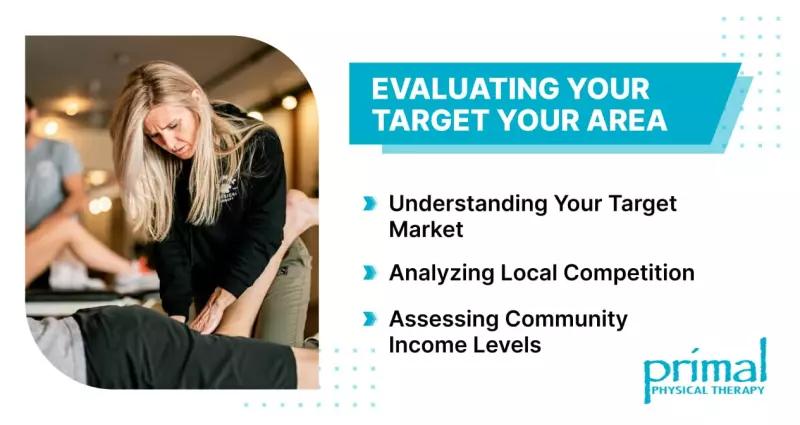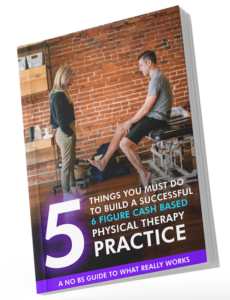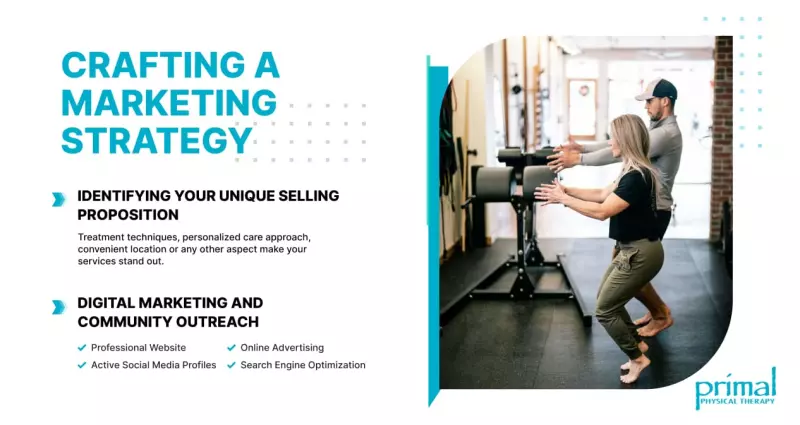Starting a cash-based physical therapy practice is a journey that blends entrepreneurial spirit with a passion for patient-centered care. This model, stepping away from the constraints of insurance-based systems, allows therapists to craft a practice that truly reflects their vision and values.
By uncovering insights and strategies to launch your practice and thrive in a competitive, ever-evolving healthcare landscape, this guide serves as your roadmap to navigate the complexities of establishing a successful cash-based clinic.

Evaluating The Viability Of A Cash-Based Model In Your Area
Evaluating the viability of a cash-based PT practice in your area is a journey of understanding your market, competition and the economic landscape.
As you consider transitioning from an insurance-based practice to owning your own cash-based practice, it’s crucial to assess if your community is ready to pay cash for physical therapy services.
Let’s dive into the key factors that will not only determine the feasibility of your venture but also set the stage for its thriving success.
Understanding Your Target Market
Imagine your ideal patient.
- Who are they?
- What are their needs, lifestyles, and financial capabilities?
- Are there athletes seeking performance enhancement, busy professionals looking for quick recovery solutions, or seniors needing gentle, restorative care?
This insight is your first beacon in determining whether your potential clients are ready and able to embrace a cash-based service.
But how do you gather this information?
Engage in local health forums, conduct surveys or participate in community events. Each interaction is a piece of the puzzle in understanding your market and tailoring your services to become an indispensable part of their health journey.
Analyzing Local Competition
Now, let’s turn the lens outward. Who else is serving these potential clients? Analyzing your competition is not about gearing up for a battle; it’s about understanding the landscape and finding your unique place.
What services are already being offered, and what can you provide differently? This isn’t just about being another option; it’s about being the better choice for a specific need.
Look beyond the numbers –– visit these practices, talk to their clients and understand their strengths and weaknesses.
This is not just about finding a gap in the market; it’s about identifying an opportunity to make a real difference.

Assessing Community Income Levels
Finally, let’s talk about money. The economic fabric of your area plays a crucial role in the viability of a cash-based practice.
High-income neighborhoods might readily embrace the idea of direct-pay healthcare, while more diverse economic areas might require a more nuanced approach to pricing and services.
This is where you need to be both a healthcare provider and a savvy entrepreneur.
Use local economic data, understand the spending habits of your community and tailor your services to fit not just their health needs but also their financial realities.
Setting Up Your Cash-Based Physical Therapy Practice
Before you open the doors to your practice, it’s essential to understand the state practice act and how it applies to cash-based practices.
This includes knowing the legalities of treating Medicare patients in a cash pay model and the implications of being out of network with third-party payers.
From navigating legal waters to creating a welcoming space for your clients, each step is crucial in building a practice that stands out and stands strong in the healthcare community.
Legal And Regulatory Considerations
Before you open your doors, you must get your legal ducks in a row. You can do so by:
- Understanding State Practice Acts and Medicare Rules: Familiarize yourself with the specific laws and regulations that govern cash-based physical therapy in your state. This includes knowing how these rules differ from those for insurance-based practices.
- Complying with Patient Documentation and Privacy Laws: Be well-versed in the legal requirements for maintaining patient records. This includes understanding the nuances of patient confidentiality and the Health Insurance Portability and Accountability Act (HIPAA) regulations.
- Adhering to Direct Patient Care Regulations: Investigate if any unique state-specific regulations apply to direct patient care in a cash-based setting. This might include rules about patient referrals, scope of practice or direct access laws.
When establishing the business structure for your private practice, consider whether a sole proprietorship, LLC, or partnership best suits your vision as a practice owner. Each option has different implications for collecting payment and managing the financial aspects of a cash-based business.
- Sole Proprietorship: This is the simplest form of business ownership and the easiest to set up. It’s ideal if you’re starting small and intend to be the sole practitioner. However, remember that your personal and business liabilities are not separate in a sole proprietorship.
- Limited Liability Company (LLC): An LLC can offer the best of both worlds — the simplicity of a sole proprietorship and the liability protection of a corporation. It’s a popular choice for small businesses, including physical therapy practices, as it protects your assets from business debts and liabilities.
- Partnership: If you’re considering starting your practice with one or more partners, a partnership could be the way to go. There are different types of partnerships (such as general, limited, and limited liability partnerships), each with its implications for liability, tax, and operations.
Don’t forget to secure business licenses, professional liability insurance and any other permits required to operate legally and safely.
Establishing Your Business Structure
With the legalities in place, it’s time to think about the nuts and bolts of your business. Setting up a business bank account is a must for keeping your personal and business finances separate. This simplifies accounting and presents a professional image to your clients and suppliers.
Furthermore, think about the kind of patient experience you want to offer. Will you have a physical location or provide services at clients’ homes or virtually?
Each option has its considerations regarding cost, convenience, and the type of services you can offer.
Creating A Welcoming And Functional Space
If you decide on a brick-and-mortar location, the design and layout of your space are more than just aesthetic choices. A welcoming, well-designed space can significantly enhance patient experience and satisfaction.
Consider accessibility, privacy and comfort in your layout. Equip your practice with the technology and tools to provide top-notch care and create a calming, welcoming space.

Financial Planning For PT Practice Owners
In the financial planning stage, it’s important for physical therapists venturing into their own business to understand the nuances of accepting payment directly from clients, which is a key aspect of running a cash-based PT.
Calculating Overhead And Setting Fees
One of the first steps in financial planning is to get a clear picture of your overhead costs. This includes rent (if you have a physical location), utilities, equipment, staff salaries, marketing expenses, and other operational costs. Understanding these figures is crucial in setting your fees.
Your pricing should cover these costs and allow for a reasonable profit margin.
- Estimating Startup and Ongoing Costs: Break down your initial investment and recurring expenses. This will give you a clear idea of how much capital you need to start and sustain your practice.
- Strategies for Pricing Services: Consider the value you provide, market rates and what your target market can afford. Your fees should reflect the quality of your services while remaining competitive and accessible to your target demographic.
Managing Cash Flow
Effective cash flow management is the lifeblood of your practice. It involves monitoring and managing the money flowing in and out of your business.
This is crucial for maintaining the financial health of your practice and ensuring you have the funds available for growth and expansion.
- Effective Billing and Payment Policies: Implement policies that ensure timely payments from your clients. Consider offering multiple payment options and clear, concise billing statements.
- Tools for Financial Tracking and Analysis: Utilize financial software or hire a professional to keep track of your finances. Regularly reviewing financial reports will help you make informed decisions and identify areas for improvement.

Crafting A Marketing Strategy For Your Practice
Your marketing efforts should resonate with your target audience, highlighting the unique benefits of your services and setting you apart in a competitive market.
Identifying Your Unique Selling Proposition
The first step in crafting your marketing strategy is identifying what makes your practice unique. This is your Unique Selling Proposition (USP).
Your specialized treatment techniques, personalized care approach, convenient location or any other aspect make your services stand out.
Digital Marketing And Community Outreach
Having a solid marketing plan and a strong online presence can be achieved by having the following:
- Professional Website: Your website is often the first point of contact between your practice and potential clients. Ensure it is user-friendly, informative and reflects the professionalism of your services. Include clear descriptions of your services, your qualifications, patient testimonials and easy-to-find contact information. Optimize your website for search engines to improve visibility.
- Active Social Media Profiles: Utilize platforms like Facebook, Instagram and LinkedIn to connect with your audience. Share engaging content such as health tips, success stories and behind-the-scenes glimpses of your practice. Regularly interacting with your followers can build a sense of community and trust.
- Online Advertising: Invest in online advertising to reach a broader audience. Platforms like Google Ads and Facebook Ads allow you to target specific demographics, ensuring that your marketing efforts reach the people most likely to benefit from your services.
- Search Engine Optimization (SEO): Optimize your online content with relevant keywords, quality backlinks and regular updates to rank higher in search engine results. This increases the visibility of your practice to individuals actively searching for physical therapy services in your area.

Developing A Patient-Centric Approach
After establishing a solid foundation for your cash-based physical therapy practice, focusing on the operational essentials is crucial.
This involves streamlining processes, implementing efficient systems and ensuring that every aspect of your practice’s operations contributes to a smooth and effective patient experience.
Implementing Efficient Systems And Processes
Efficiency is key in healthcare, especially in a cash-based practice where patient experience is paramount.
Implementing streamlined systems for appointments, billing and patient management enhances the patient experience and ensures your practice runs smoothly.
Maintaining High Standards Of Care And Compliance
Maintaining high standards of care and compliance is non-negotiable in a healthcare practice.
This involves:
- Ongoing Professional Development: Regularly update your skills and knowledge in physical therapy. Attend workshops, seminars and training sessions to stay abreast of the latest developments in your field.
- Ensuring Compliance with Healthcare Regulations: Stay informed about healthcare regulations and ensure your practice is always compliant. This includes patient privacy laws, treatment protocols and other relevant regulations.
- Building a Skilled and Empathetic Team: If you have staff, ensure they share your commitment to patient-centric care. Train your team in clinical skills, communication, and empathy.
Operational Essentials For Your Practice
Ensuring your cash-based physical therapy practice runs smoothly is a blend of efficient administration, high-quality clinical care, a welcoming environment and a positive workplace culture.
Let’s explore these operational essentials in detail.
Streamlining Administrative Processes
Efficient administrative processes are vital for a well-functioning practice. Implementing effective practice management software can revolutionize how you handle patient records, scheduling and billing, leading to increased efficiency and reduced errors. A systematic approach to billing and invoicing, with clear payment policies and timely receivables follow-up, is essential.
This streamlines your financial operations and enhances patient satisfaction by providing clarity and transparency in financial dealings.
Maintaining A High Standard Of Clinical Care
The cornerstone of your practice is the quality of clinical care you provide. Regular training and professional development are crucial to stay updated with the latest physical therapy techniques and treatments.
Implementing quality control processes and actively seeking patient feedback are key strategies to improve care quality continuously.

Creating A Comfortable And Safe Environment
The physical environment of your practice significantly impacts the patient experience. Ccreate a space that is aesthetically pleasing but also functional and accessible.
Ensure that your practice’s design prioritizes patient comfort and privacy, with well-equipped treatment rooms and a relaxing waiting area.
Adherence to strict safety and hygiene protocols is essential to ensure the well-being of both patients and staff, thereby fostering a safe and healing environment.
Fostering A Positive Workplace Culture
Encouraging team collaboration and open communication creates a harmonious work environment, directly translating to better patient care.
Prioritizing your staff’s well-being and professional development is also crucial. A valued and supported team is more engaged and motivated, leading to higher productivity and a better patient experience.
Start Your Cash-Based Physical Therapy Practice Now
Embarking on the journey to start your own cash-based practice is a bold step for any physical therapist. It’s a move away from traditional third-party payers and towards a more direct relationship with your patients.
Your dedication to this cash-based business model as a practice owner will be the cornerstone of your success. Remember, the success of your practice hinges on your commitment to excellence, continuous improvement and adaptability to the changing needs of your patients and the healthcare landscape.
Explore our courses for more insights and guidance on your journey to creating a practice that stands out in its commitment to quality care and patient satisfaction.


